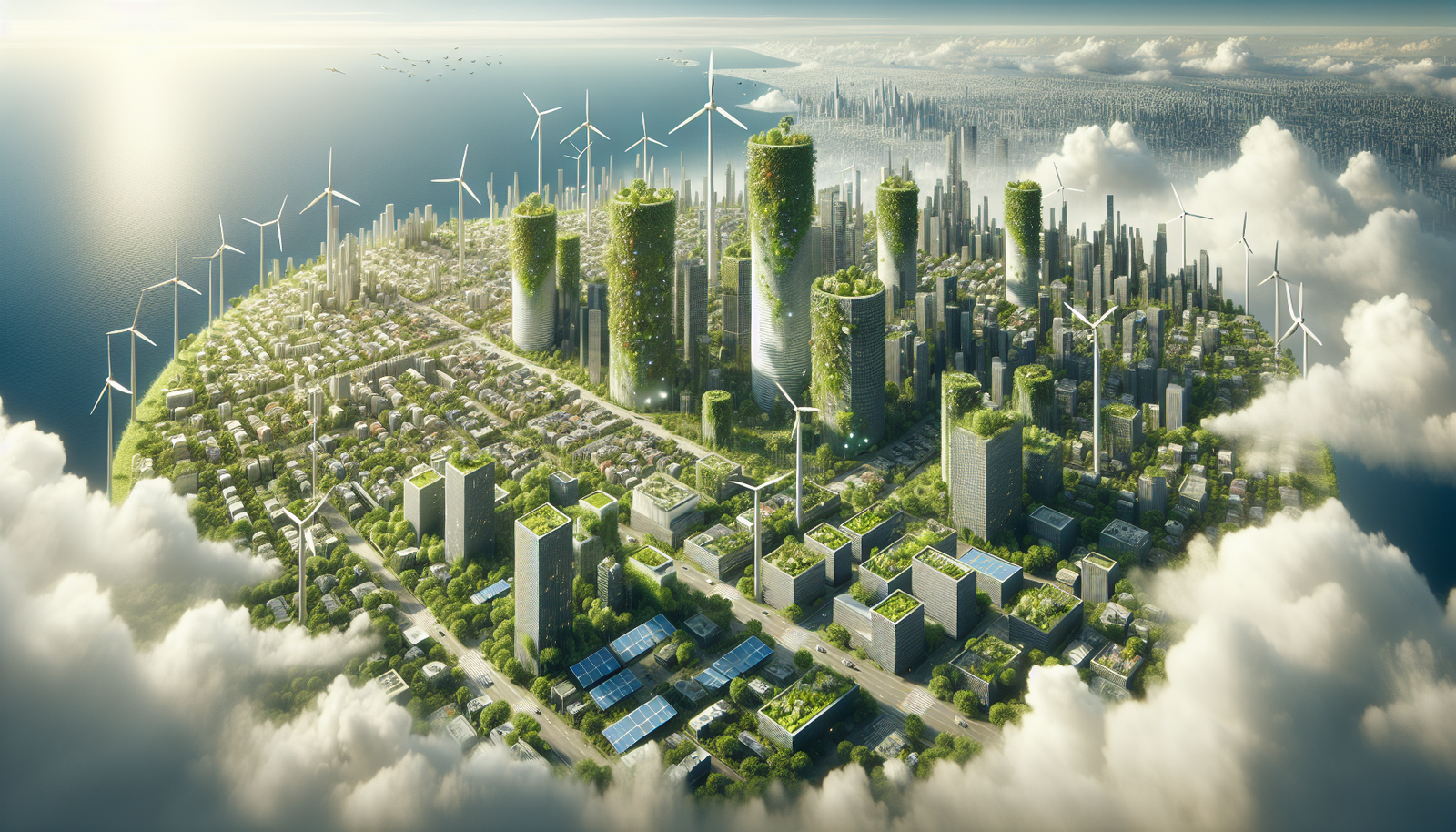Understanding Sustainability
Sustainability is a concept that has gained significant traction in recent years, primarily due to the growing awareness of environmental issues and their long-term implications. At its core, sustainability is about meeting our present needs without compromising the ability of future generations to meet theirs. This involves a careful balance of economic growth, environmental stewardship, and social inclusion.
The importance of understanding sustainability lies in its multifaceted impact on our daily lives and the planet. Environmental sustainability focuses on reducing the depletion of natural resources to maintain ecological balance. This includes efforts to reduce carbon emissions, protect biodiversity, and promote renewable energy sources. Economic sustainability, on the other hand, emphasizes the efficient use of resources to ensure economic growth and stability over the long term. Finally, social sustainability is about fostering a society that values human rights, equality, and access to basic needs.
| Aspect | Description |
|---|---|
| Environmental | Focuses on reducing pollution, conserving natural resources, and protecting ecosystems. |
| Economic | Involves creating economic systems that provide a reasonable quality of life while minimizing resource depletion. |
| Social | Ensures that social equity, human rights, and community development are prioritized. |
To fully grasp the concept of sustainability, it is essential to recognize the interconnectedness of these aspects. A sustainable future can only be achieved when environmental, economic, and social systems work in harmony. This understanding forms the foundation for developing effective strategies and policies that address global challenges such as climate change, poverty, and inequality.
- Environmental Initiatives: Promoting renewable energy, reducing waste, and conserving natural habitats.
- Economic Strategies: Encouraging sustainable business practices and supporting green technologies.
- Social Efforts: Ensuring fair labor practices and improving access to education and healthcare.
Historical Context and Evolution
The concept of sustainability has evolved significantly over time, becoming a central tenet in global discourse. Initially, sustainability was primarily associated with environmental conservation efforts that emerged during the industrial revolution. As industries grew, so did the awareness of the environmental degradation they caused. This period marked the start of organized conservation movements, with prominent figures advocating for the protection of natural resources.
In the mid-20th century, sustainability began to encompass economic and social dimensions. The publication of the Brundtland Report in 1987 was a pivotal moment, as it defined sustainable development as “development that meets the needs of the present without compromising the ability of future generations to meet their own needs.” This broader understanding paved the way for global initiatives such as the United Nations’ Sustainable Development Goals (SDGs), which emphasize a holistic approach to sustainability.
As we move into the 21st century, technological advancements have further shaped the evolution of sustainability. Innovations in renewable energy, waste management, and sustainable agriculture have accelerated the transition towards more sustainable practices. These technological solutions are often driven by data, enabling more efficient resource management and reducing environmental impact.
- Environmental Conservation: Initiatives focused on protecting ecosystems and biodiversity.
- Economic Sustainability: Strategies aimed at promoting economic growth while preserving natural resources.
- Social Sustainability: Efforts to ensure equitable access to resources and opportunities.
Today, sustainability is a multifaceted concept that requires cooperation across various sectors. Governments, corporations, and individuals play essential roles in fostering sustainable practices. The evolution of sustainability reflects a growing recognition of the interconnectedness of our global systems and the need for a balanced approach to development.
Environmental Impact and Challenges
The environmental impact of sustainability is multifaceted, addressing numerous challenges that our planet faces today. The primary focus is on reducing carbon emissions, conserving natural resources, and protecting ecosystems. Sustainability practices aim to mitigate the adverse effects of climate change, which is crucial for preserving biodiversity and maintaining ecological balance. One of the significant challenges is the over-reliance on fossil fuels, which contributes to greenhouse gas emissions and global warming.
Renewable energy sources such as solar, wind, and hydroelectric power play a pivotal role in minimizing environmental impact. These technologies have become more accessible and cost-effective, leading to an increase in their adoption worldwide. However, transitioning to renewable energy presents challenges, including the need for significant infrastructure investment and the intermittent nature of some renewable sources. Implementing energy storage solutions and smart grid technologies can help address these challenges.
Another critical aspect of sustainability is waste management. The global increase in waste production poses a severe threat to the environment, necessitating effective recycling and waste reduction strategies. Innovative approaches such as circular economy models, which emphasize the reuse and regeneration of materials, are being explored to tackle waste-related challenges. These models not only reduce environmental impact but also promote economic growth by creating new business opportunities.
To provide a clearer picture of the current state and challenges, consider the following data representation:
| Challenge | Impact | Potential Solution |
|---|---|---|
| Carbon Emissions | Global Warming | Adoption of Renewable Energy |
| Resource Depletion | Loss of Biodiversity | Sustainable Resource Management |
| Waste Production | Environmental Pollution | Circular Economy Models |
Economic Benefits of Sustainable Practices
Sustainable practices offer myriad economic benefits that extend beyond environmental conservation. By integrating sustainability into business operations, companies can significantly reduce costs through efficient resource management and waste reduction. Energy efficiency is a prime example; by investing in energy-saving technologies, companies can lower their energy bills, which in turn enhances profit margins. This approach not only benefits individual companies but also contributes to a more resilient economy by reducing dependency on volatile energy markets.
Moreover, sustainable practices open up new markets and opportunities for innovation. Green technologies and sustainable products are in increasing demand, providing businesses with the potential to capitalize on new revenue streams. Companies that prioritize sustainability are also more likely to attract and retain customers who are conscious of the environmental and social impact of their purchases. This consumer preference for sustainable goods can drive higher sales and foster brand loyalty.
Beyond direct financial gains, sustainability can enhance a company’s reputation and competitiveness. Businesses that demonstrate a commitment to environmental and social responsibility often enjoy a positive public image, which can lead to increased trust and investment. A survey conducted by a leading research firm found that 75% of consumers are willing to pay more for sustainable products, underscoring the economic advantage of adopting sustainable practices.
To further illustrate the economic impact, consider the following table that outlines the financial benefits reported by companies after implementing sustainable practices:
| Benefit | Percentage of Companies Reporting |
|---|---|
| Cost savings from energy efficiency | 65% |
| Increased sales of sustainable products | 55% |
| Improved brand reputation | 70% |
Overall, the economic benefits of sustainable practices are substantial and multifaceted. By investing in sustainability, businesses not only contribute to environmental preservation but also position themselves for long-term economic success and stability.
Social Equity and Community Development
Social equity is a fundamental aspect of sustainability, emphasizing the fair distribution of resources and opportunities. It seeks to ensure that all individuals, regardless of their socio-economic status, have access to essential services and a healthy environment. Community development plays a pivotal role in achieving social equity by fostering inclusive growth and empowering marginalized groups. The integration of sustainability into community development initiatives can lead to more resilient and adaptable communities.
One of the key components of social equity is access to quality education and healthcare. These sectors not only improve individual well-being but also enhance community resilience. For example, sustainable practices in education, such as integrating environmental literacy into curricula, equip future generations with the knowledge and skills needed to address ecological challenges. Similarly, community health programs that focus on preventive care and holistic wellness contribute to the overall sustainability of a community.
| Area | Impact on Social Equity |
|---|---|
| Education | Enhances knowledge and skills for addressing sustainability issues |
| Healthcare | Improves community health through preventive care initiatives |
Sustainability also involves fostering community participation and engagement in decision-making processes. By involving local communities in planning and development, projects are more likely to meet the actual needs of the population and gain widespread support. Successful examples include community-led renewable energy projects and urban agriculture initiatives, which not only promote environmental sustainability but also create economic opportunities and strengthen social cohesion.
- Community-led renewable energy projects
- Urban agriculture initiatives
- Inclusive policy-making processes
In conclusion, integrating social equity and community development into sustainability efforts ensures that no group is left behind. It is essential for creating a future where all communities can thrive in harmony with the environment, leading to a more just and equitable world. As we advance, it is crucial to continue exploring innovative ways to blend these elements into policy and practice.
Technological Innovations Driving Sustainability
Technological innovations are at the forefront of driving sustainability, offering solutions that significantly reduce environmental impact while promoting economic efficiency. Innovations in renewable energy, such as solar panels and wind turbines, have revolutionized how we harness natural resources, making energy production cleaner and more sustainable. These technologies not only reduce our carbon footprint but also pave the way for energy independence and security.
One of the most promising areas of technological advancement is in the field of energy storage. Improved battery technologies, such as lithium-ion and emerging solid-state batteries, are critical for storing renewable energy, ensuring a consistent energy supply even when the sun isn’t shining or the wind isn’t blowing. The integration of smart grids further optimizes energy use by efficiently managing supply and demand, reducing waste, and lowering costs for consumers.
Beyond energy, sustainable agriculture technologies are reshaping the way we produce food. Innovations such as vertical farming and precision agriculture use less land and water while increasing yield. By utilizing data and AI, farmers can optimize resource use, minimize chemical inputs, and improve crop resilience. This not only enhances food security but also reduces the ecological footprint of agriculture.
Moreover, the rise of the circular economy is facilitated by innovations in recycling and material science. Technologies that enable the efficient breakdown and reuse of materials are crucial in reducing waste and promoting sustainable consumption. Advanced sorting systems and biodegradable materials are some examples of how technology is enabling a shift towards a more sustainable future.
| Technology | Impact on Sustainability |
|---|---|
| Solar Panels | Reduction in carbon emissions, renewable energy source |
| Smart Grids | Efficient energy management, reduced energy waste |
| Vertical Farming | Less land and water usage, increased food production |
| Recycling Technologies | Reduced waste, promotion of circular economy |
Corporate Responsibility and Sustainable Business Models
Corporate responsibility has become a pivotal component in the pursuit of sustainability, as businesses are increasingly held accountable for their environmental and social impact. Companies are now adopting sustainable business models that integrate ethical practices with profitability. This shift is driven by both consumer demand and regulatory pressures. Consumers are more informed and concerned about the origins and effects of the products they purchase, prompting businesses to adopt more transparent and sustainable practices.
One essential aspect of corporate responsibility is the commitment to reducing carbon footprints. Many corporations are investing in renewable energy sources, aiming to decrease their reliance on fossil fuels. This not only helps in mitigating climate change but also reduces operational costs in the long run. Companies are also focusing on reducing waste through recycling and reusing materials, thus promoting a circular economy. Below is a table illustrating the benefits of adopting sustainable business models:
| Benefit | Description |
|---|---|
| Cost Savings | Reduced energy consumption and waste lead to significant savings. |
| Brand Loyalty | Consumers prefer brands that are committed to sustainability. |
| Regulatory Compliance | Meeting environmental regulations avoids legal penalties. |
Moreover, businesses are exploring innovative approaches such as green technologies and sustainable supply chains. These initiatives not only enhance their competitive edge but also contribute to broader societal goals. A successful example can be seen in the fashion industry, where companies are adopting eco-friendly materials and ethical labor practices. The move towards sustainability is further reinforced by global policies that incentivize environmentally-friendly practices, creating a more favorable ecosystem for sustainable business models.
In conclusion, the integration of corporate responsibility and sustainable business models is not just a trend but a necessity for future resilience. Companies that embrace these principles not only benefit the environment and society but also secure their long-term success. As sustainability continues to shape the business landscape, it is imperative for corporations to align their strategies with sustainable development goals.
Government Policies and Global Agreements
Government policies play a pivotal role in driving sustainability efforts across the globe. National and local governments are increasingly implementing policies aimed at reducing carbon emissions, promoting renewable energy, and encouraging sustainable practices. These policies are designed to not only protect the environment but also to foster economic growth and social well-being. For instance, many countries have introduced carbon pricing mechanisms to incentivize businesses to lower their carbon footprint. Furthermore, subsidies and tax incentives for renewable energy projects are becoming more common, making sustainable energy sources more competitive against traditional fossil fuels.
On a global scale, international agreements have been instrumental in uniting nations towards common sustainability goals. The Paris Agreement, adopted in 2015, is a landmark accord that brings countries together to combat climate change and limit global warming to below 2 degrees Celsius. This agreement requires countries to set and achieve ambitious targets for reducing greenhouse gas emissions. Additionally, the United Nations’ Sustainable Development Goals (SDGs) provide a comprehensive framework for addressing a wide range of sustainability issues, from poverty and education to clean energy and climate action.
These policies and agreements are supported by a variety of data-driven strategies to ensure their effectiveness and transparency. Governments and international organizations use data analytics and visualizations to monitor progress, identify challenges, and share insights. For example, the following table illustrates the progress of selected countries in achieving their carbon reduction targets under the Paris Agreement:
| Country | Target Reduction (%) | Current Reduction (%) | Status |
|---|---|---|---|
| Country A | 30% | 25% | On Track |
| Country B | 40% | 35% | Needs Improvement |
| Country C | 25% | 28% | Exceeded |
These cooperative efforts demonstrate the power of collective action in addressing global challenges. By aligning policies and leveraging international agreements, countries can achieve more sustainable development, benefiting not only their citizens but the entire planet. As we move forward, continuous collaboration and innovation in policy-making will be essential to meet the ever-evolving demands of sustainability.
Personal Actions and Lifestyle Changes
Individual actions play a pivotal role in driving sustainability forward. Each person’s efforts can collectively lead to significant environmental benefits. Simple changes in daily routines can have a profound impact. For instance, by reducing energy consumption in our homes, we not only lower our carbon footprint but also reduce our utility bills. Choosing public transportation, biking, or walking instead of driving can significantly decrease greenhouse gas emissions.
Additionally, adopting a plant-based diet is another effective way to reduce environmental impact. Animal agriculture is a major contributor to deforestation, water shortages, and greenhouse gas emissions. By consuming more plant-based foods, individuals can contribute to a more sustainable food system. According to recent studies, if everyone in the United States reduced their meat consumption by even one meal a week, the environmental benefits would be equivalent to taking millions of cars off the road.
- Reduce, Reuse, Recycle: Embrace the 3R principle to minimize waste.
- Support local and sustainable businesses to boost the green economy.
- Conserve water by fixing leaks and using water-efficient appliances.
Moreover, it is essential to educate and inspire others to adopt sustainable practices. Sharing knowledge about the importance of sustainability and demonstrating these actions can influence friends, family, and the community. Social media platforms can be powerful tools for spreading awareness and encouraging collective action.
| Action | Impact |
|---|---|
| Using energy-efficient appliances | Reduces energy consumption by up to 30% |
| Choosing renewable energy sources | Decreases reliance on fossil fuels |
| Adopting a zero-waste lifestyle | Minimalizes landfill contributions |
Education and Awareness
Education and awareness are pivotal in promoting sustainability. With the growing need for sustainable practices, it is essential to integrate environmental education at all levels of learning. By incorporating sustainability topics into school curriculums, students become more informed about the importance of preserving natural resources. This foundational knowledge empowers young individuals to make conscious decisions that positively impact the environment.
Moreover, community awareness programs play a crucial role in spreading sustainability knowledge. Through workshops and seminars, individuals can learn practical methods to reduce their carbon footprint. These initiatives not only educate but also inspire communities to adopt sustainable lifestyles. Successful programs often include interactive activities that demonstrate the tangible benefits of sustainable practices, fostering a culture of environmental responsibility.
The impact of education on sustainability can be illustrated through a variety of data visualizations. For example, an increase in recycling rates can be observed in communities with active educational campaigns. Additionally, statistics show that regions with comprehensive sustainability education report higher levels of public participation in green initiatives.
| Region | Recycling Rate Before Education (%) | Recycling Rate After Education (%) |
|---|---|---|
| Region A | 25 | 45 |
| Region B | 30 | 55 |
| Region C | 20 | 50 |
As highlighted in the table, educational initiatives have a significant impact on improving recycling efforts. By prioritizing education and awareness, societies can foster a more sustainable future, encouraging individuals to take action and embrace environmental stewardship.
Case Studies of Successful Sustainability Initiatives
The Essential Role of Sustainability in Our Future cannot be overstated, and examining real-world examples offers invaluable insights. Several case studies highlight the transformative power of sustainability initiatives across different sectors. These initiatives not only demonstrate the feasibility but also the benefits of adopting sustainable practices.
One notable example is the renewable energy sector in Germany. The country’s commitment to the “Energiewende” policy has resulted in a significant increase in the use of renewable energy sources. This initiative has led to a reduction in carbon emissions and has set a benchmark for other countries. As of 2020, approximately 46% of Germany’s electricity consumption was generated from renewable sources. The table below summarizes the growth of renewable energy in Germany over the past decade:
| Year | Renewable Energy (%) |
|---|---|
| 2010 | 17% |
| 2015 | 31% |
| 2020 | 46% |
Another impactful case is the adoption of sustainable agricultural practices in Kenya. Through the implementation of agroforestry, local farmers have improved crop yields while restoring soil fertility. This initiative has not only enhanced food security but also provided economic benefits by diversifying income streams. Key strategies include:
- Intercropping trees with crops to improve soil quality.
- Using organic fertilizers to reduce chemical dependency.
- Implementing water conservation techniques.
These case studies emphasize the potential of sustainability initiatives to drive positive change. By integrating sustainable practices, communities and industries can address environmental challenges while fostering economic and social development. The lessons learned from these examples serve as a guide for future projects aimed at creating a sustainable future for all.
Challenges and Barriers to Implementation
The path to achieving sustainability is fraught with numerous challenges and barriers that impede progress across various sectors. One of the primary obstacles is the economic cost associated with implementing sustainable practices. Transitioning from traditional methods to more sustainable alternatives often requires significant initial investments, which can be a deterrent for businesses and governments alike. Despite the long-term savings and benefits, the upfront costs can be prohibitive, especially for small to medium-sized enterprises and developing nations.
Another major barrier is the lack of awareness and education regarding sustainable practices. Many individuals and organizations are not fully informed about the benefits of sustainability or how to effectively implement such practices in their daily operations. This lack of knowledge can lead to resistance or apathy, further slowing the adoption of necessary changes. Educational campaigns and accessible resources are crucial in overcoming this hurdle, yet they are often inadequately funded or prioritized.
| Barrier | Description |
|---|---|
| Economic Cost | High initial investments required for sustainable practices. |
| Lack of Awareness | Insufficient knowledge about the benefits and implementation of sustainability. |
| Policy Gaps | Inconsistent regulations and standards across regions. |
Compounding these issues are policy gaps and inconsistencies in regulations across different regions. The absence of a unified global framework for sustainability creates disparities in implementation and enforcement, making it challenging to achieve cohesive progress. Some countries may have stringent regulations, while others lack even basic guidelines, leading to a patchwork of policies that can hinder international collaboration and progress.
Addressing these challenges requires a coordinated effort from all stakeholders, including governments, businesses, and individuals. Collaborative approaches and innovative solutions are essential to overcome the financial, educational, and regulatory barriers that currently stand in the way of a sustainable future.
Future Trends in Sustainability
The future of sustainability is poised to be shaped by several key trends that promise to revolutionize the way we approach environmental, economic, and social challenges. Technological advancements are at the forefront, with innovations such as artificial intelligence, blockchain, and the Internet of Things (IoT) playing a pivotal role in enhancing resource efficiency and reducing waste. These technologies enable real-time monitoring of environmental impacts, optimize supply chains, and foster transparency in corporate practices. As technology continues to evolve, it will underpin efforts to achieve greater sustainability across various sectors.
Another significant trend is the increasing corporate commitment to sustainability. Companies worldwide are recognizing the importance of integrating sustainable practices into their core operations, not just for ethical reasons but also for economic benefits. Many organizations are setting ambitious targets to reduce carbon emissions, minimize waste, and promote sustainable sourcing. These commitments are often driven by consumer demand for environmentally friendly products and services, as well as regulatory pressures. A growing number of businesses are adopting circular economy principles, focusing on reducing, reusing, and recycling materials to create closed-loop systems.
In terms of global policies, there is a notable shift towards more stringent environmental regulations and international agreements aimed at combating climate change. Governments are increasingly collaborating to set targets for reducing greenhouse gas emissions and promoting renewable energy. Policies that encourage investment in sustainable infrastructure and green technologies are being prioritized, with the aim of fostering economic growth while safeguarding the planet. These initiatives are crucial for meeting international sustainability goals, such as the United Nations’ Sustainable Development Goals (SDGs).
The table below highlights some of the successful initiatives and projections for future trends in sustainability:
| Initiative | Description | Impact |
|---|---|---|
| Renewable Energy Adoption | Increasing use of solar, wind, and other renewable sources. | Reduction in carbon footprint and energy costs. |
| Smart Cities | Integration of technology to improve urban living. | Enhanced efficiency and reduced resource consumption. |
| Sustainable Agriculture | Use of eco-friendly farming practices. | Improved food security and biodiversity. |



